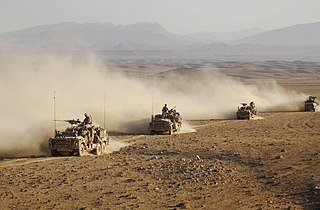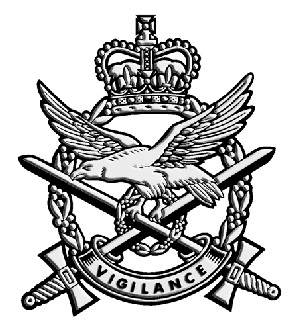
The Special Air Service Regiment, officially abbreviated SASR though commonly known as the SAS, is a special forces unit of the Australian Army. Formed in 1957 as a company, it was modelled on the British SAS with which it shares the motto, "Who Dares Wins". Expanded to a regiment in August 1964, it is based at Campbell Barracks, in Swanbourne, a suburb of Perth, Western Australia, and is a direct command unit of the Special Operations Command.

The 1st Commando Regiment is an Australian Army Reserve special forces unit, part of Special Operations Command with an integrated structure of regular (full-time) soldiers and reserve (part-time) soldiers, which together with the full-time Australian Army 2nd Commando Regiment, provides the commando capability to Special Operations Command. Raised in 1955 it is the oldest unit within Special Operations Command and in 2008 deployed to Afghanistan to become the first Australian Army Reserve force element on combat operations since World War II. The regiment is the Command's capability lead for special warfare.

The Special Operations Command (SOCOMD) is an Australian Defence Force command that was established on 5 May 2003 to unite all of the Australian Army's special forces units and by 2008 was fully operational. Australia's Special Operations Command is of equivalent status to Australia's Fleet, Forces and Air Commands. It is modelled on the equivalent commands in the United States and British military forces, and is led by a major general as Special Operations Commander Australia (SOCAUST).

The 3rd Battalion, Royal Australian Regiment is a mechanised infantry battalion of the Australian Army, based in Kapyong Lines, Townsville as part of the 3rd Brigade. 3 RAR traces its lineage to 1945 and has seen operational service in Japan, Korea, Malaya, Borneo, South Vietnam, Rifle Company Butterworth, East Timor, the Solomon Islands, Afghanistan and Iraq.

The 171st Special Operations Aviation Squadron is an Australian Army helicopter squadron that provides aviation support to the Special Operations Command. The squadron is being equipped with the UH-60M Black Hawk helicopter. The squadron is based at Luscombe Airfield, Holsworthy Barracks, Sydney and forms part of the 6th Aviation Regiment as the regiment's sole operational squadron.

The special forces of the Australian Defence Force are units of Special Operations Command and associated units of the Royal Australian Navy and the Royal Australian Air Force that conduct and or support special operations to advance and protect the national security of the Commonwealth of Australia. The special forces of Australia have a lineage to a variety of units raised in the Second World War such as the Independent and Commando Companies, Z Special Unit, Navy Beach Commandos, and the Coastwatchers. Australian special forces have most recently been deployed to Iraq in Operation Okra as the Special Operations Task Group, as the Special Operations Task Group in Afghanistan, in Afghanistan in support of the Australian Secret Intelligence Service and regularly for counter-terrorism pre-deploy to locations of major domestic events throughout Australia in readiness to support law enforcement such as the 2014 G20 Brisbane summit.

The Australian Army Aviation (AAAvn) is an administrative corps of the Australian Army. It was formed on 1 July 1968. The motto of the Australian Army Aviation corps is Vigilance.

The Australian Defence Force Parachuting School is an Australian Army unit part of the Defence Special Operations Training and Education Centre (DSOTEC) that provides training in parachuting techniques, develops parachute doctrine and techniques and conducts trial-evaluations of parachute systems and associated equipment. The school is based adjacent to HMAS Albatross, Nowra, New South Wales.
The 173rd Special Operations Aviation Squadron is an Australian Army helicopter training squadron that provides support to the Special Operations Command. The squadron is being equipped with UH-60M Black Hawk helicopters. The squadron is based at Luscombe Airfield, Holsworthy Barracks, Sydney and forms part of the 6th Aviation Regiment.

The 6th Aviation Regiment is one of the Australian Army's three Army Aviation regiments and was raised on 1 March 2008 to provide air mobility for the Australian Army Special Operations Command (SOCOMD).

The 2nd Commando Regiment is a special forces unit of the Australian Army and is part of Special Operations Command. The regiment was established on 19 June 2009 when the 4th Battalion RAR (Commando) was renamed. It is based at Holsworthy, New South Wales. The 2nd Commando Regiment trains and has served with coalition special forces units, and is highly regarded by these units. The regiment has been involved in operations in East Timor, Iraq and Afghanistan, where it was used in a direct action warfighting role. It has also been involved in domestic security operations including the 2006 Commonwealth Games and the 2014 G20 Leaders Summit. In 2019, the regiment was made the Command's capability lead for strategic strike.
The 17th Sustainment Brigade currently commands the Australian Army's deployable operational level logistics units. Raised on 20 May 2006, the brigade was formerly known as the Logistic Support Force (LSF), and is made up of varied logistic corps and trades. It encompasses both reserve and full-time units, geographically dispersed throughout Australia. Headquartered in Sydney, New South Wales its primary deployable command element is the Force Sustainment Group. The units of the brigade are responsible for providing third line or 'general' support within an area of operations. The brigade was designated the 17th Combat Service Support Brigade until 1 August 2019, when it was renamed the 17th Sustainment Brigade. The brigade traces its origins back to the 1st Australian Logistic Support Group formed during the Vietnam War.
The 16th Aviation Brigade commands all the Australian Army aviation units and has technical control of the Army Aviation Training Centre reporting to Army Aviation Command. The Brigade was formed on 2 April 2002 by combining Headquarters Divisional Aviation and Headquarters Aviation Support Group and is headquartered in Enoggera Barracks, Queensland. It was originally named Headquarters 16th Brigade (Aviation) and was renamed to the 16th Aviation Brigade.
Forces Command (FORCOMD) is the largest command within the Australian Army responsible for the combat brigades, the enabling and training formations reporting to the Chief of the Army with approximately 85% of the Army's personnel. The Command was formed on 1 July 2009 with the amalgamation of Land Command and Training Command, and is led by a major general as the Commander Forces Command.

Operation Okra is the Australian Defence Force (ADF) contribution to the military intervention against the Islamic State. The force is part of Joint Task Force 633 in the Middle East. The operation commenced on 31 August 2014, and its initial stated aim was to combat ISIL threats in Iraq. In September 2015, the Australian airstrikes were extended to Syria. In June 2017, flights in Syria were temporarily halted in response to American forces shooting down a Syrian Air Force jet, before later being resumed.

Airborne forces raised by Australia have included a number of conventional and special forces units. During the Second World War the Australian Army formed the 1st Parachute Battalion; however, it did not see action. In the post-war period Australia's parachute capability was primarily maintained by special forces units. In the early 1980s a parachute infantry capability was revived which led to the Parachute Battalion Group forming in 1983 based on the 3rd Battalion, Royal Australian Regiment. In 1997, a full time commando regiment was raised that was able to conduct large-scale operations which matured during the 2000s. In 2011, 3 RAR relinquished the parachute role with the Army deciding to opt out of a conventional parachute capability in preference to a special forces large-scale parachute capability.

The Australian Multicam Camouflage Uniform (AMCU) is the combat uniform camouflage pattern for the Australian Defence Force, general issued from 2014 onwards. The AMCU is replacing the previously used Disruptive Pattern Camouflage Uniform (DPCU) and Australian Multicam Pattern - Operational Combat Uniform (AMP-OCU) camouflage patterns.

The Special Operations Logistic Squadron (SOLS) is an independent and specialised unit of the Australian Army based in Sydney which provides specialist logistical support to all units of the Special Operations Command in support of special operations. It has developed a "jack of all trades" capability across military logistics including rapid prototyping and metal fabrication.
The Regional Force Surveillance Group (RFSG) was formally established on 4 October 2018 to command the Australian Army Reserve's three Regional Force Surveillance Units and a training unit. The RFSG forms part of the 2nd Division.














